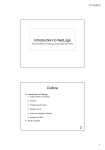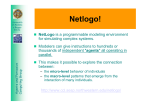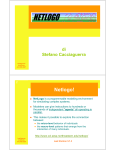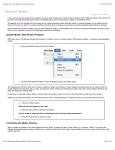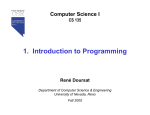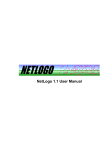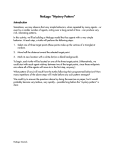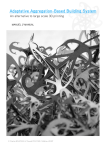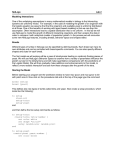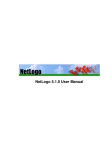Download NetLogo Implementation of Evacuation Scenario
Transcript
Introduction to NetLogo Intelligent Systems, Interaction and Multimedia Seminar 2012/2013 Outline Introduction to NetLogo Turtles, Patches, and others GUI Programming Concepts Extensions & Tools A simple example Introduction to NetLogo (I): What is NetLogo A programmable modelling environment for simulating natural and social phenomena (Uri Winlensky 1999) Agent-based M&S tool Well suited for modelling complex systems Hundreds or thousands of independent agents operating concurrently Exploring the connection between the micro-level behaviour of individuals and the macro-level patterns that emerge from the interaction of many individuals Introduction to NetLogo (I): What is NetLogo Easy-to-use application development environment Quickly testing hypotheses about self-organized systems Open simulations and play with them Large collection of pre-written simulations in natural and social sciences that can be used and modified Simple scripting language User-friendly graphical interface Introduction to NetLogo (II): The World of NetLogo NetLogo consists of agents living in a 2-D world divided into a grid of patches Three different type of agents plus one more Turtles, are the agents that move around the world Patches, are the pieces of “ground” on which turtles can move Links, are agents that connect two turtles Observer, is an agent without location that oversees everything going on in the world. Ask agents to perform a command Collects data from models Patches, Turtles, System Patches: Elements of space Change Do not move Turtles: “Social” actors Change Mobile All turtles and patches put together Typically, we wish to observe the system How many turtles are sick? Alive? “Rules” Turtles and patches have rules that can Change themselves (reflexive) Change other turtles Change other patches Rules for Turtles Reflexive behaviour ask turtles [ forward 1 ] Reflexive state ask turtles [ if (sick?) [ set color blue ] ] Change other turtles If (sick?) [ ask turtles here [ set sick? true set color blue] ] Change patches ask turtles if (sick?) [ ask patch-here [ set grass grass – 5 ]] Rules for Patches Reflexive state: patches change themselves ask patches [set grass grass + 1 ] Change other patches ask patches in-radius 1 [ set grass 0.1 * my-grass ] Change turtles ask turtles-here [ set sick? true set color blue ] in Summary Tself Pself T-to-T P-to-P T-to-P P-to-T Introduction to NetLogo (III): GUI - Controls, Settings, Views Introduction to NetLogo (III): GUI - Controls, Settings, Views controls (BLUE) - allow to run and control the flow of execution buttons command centre settings (GREEN) - allow to modify parameters sliders switches choosers views (BEIGE) - allow to display information monitors plots output text areas graphics window Introduction to NetLogo (III): GUI - Controls Controls - allow to run and control the flow of execution Buttons Command center Buttons - initialize, start, stop, step through the model “Once” buttons execute one action (one step) “Forever” buttons repeat the same action Command center - ask observer, patches or turtles to execute specific commands during the execution Introduction to NetLogo (IV): GUI - Settings Settings - allow to modify parameters Sliders Switches Sliders - adjust a quantity from min to max by an increment Switches - set a Boolean variable (true/false) Choosers - select a value from a list Introduction to NetLogo (V): GUI - Views Views - allow to display information Monitors Plots Graphics window Monitors - display the current value of variables Plots - display the history of a variable’s value Introduction to NetLogo (V): GUI - Views Graphics window - The main view of the 2-D NetLogo world Adjust speed right-click brings up turtle/patch inspector Introduction to NetLogo (VI): Programming Concepts Agents Procedures Variables Ask Agentsets Breeds Synchronization Introduction to NetLogo (VI): Programming Concepts - Agents Each agent can carry out its own activity, all simultaneously Patches Form the 2D world – They don’t move, but they sense They have integer coordinates (pxcor, pycor) Can generate turtles Turtles move on top of the patches have decimal coordinates (xcor, ycor) and orientation (heading) Observer Can create new turtles Can have read/write access to all the agents and variables Introduction to NetLogo (VI): Programming Concepts - Procedures Procedures tell agents what to do Command is an action for an agent to carry out Usually begin with verbs to setup clear all create 10 end to draw-polygon [ num-sides size ] pd repeat num-sides [ fd size rt (360 / num-sides) ] end Introduction to NetLogo (VI): Programming Concepts - Procedures Reporter computes a result and report it Usually begin with nouns or nouns-phrases to-report absolute-value [ number ] ifelse number >= 0 [ report number ] [ report 0 - number ] end Procedures: Commands or Reporters implemented by the user Primitives: Commands or Reporters built into NetLogo(language keywords) Introduction to NetLogo (VI): Programming Concepts – Variables (i) Variables Global variables Turtle & patch variables Local variable Global variables Every agent can access it Only one value for the variable Turtle & Patch variables Each turtle/patch has its own value for every turtle/patch variable Local variables Defined and accessible only inside a procedure Created by the command let Introduction to NetLogo (VI): Programming Concepts – Variables (ii) Built-in: Turtle variables: color, xcor, ycor, heading, etc Patch variables: pcolor, pxcor, pycor, etc Defining global variables: global [ clock ] Defining turtle/patch variables: turtles-own [ energy speed ] patches-own [ friction ] Defining a local variable: to swap-colors [ turtle1 turtle2 ] let temp color-of turtle1 …. Introduction to NetLogo (VI): Programming Concepts - Ask Ask - specify commands to be run by turtles or patches Examples asking all turtles: ask turtles [ fd 50 ... ] asking one turtle: ask turtle 5 [ ... ] asking all patches ask patches [ diffuse ... ] Only the observer can ask all turtles or all patches Introduction to NetLogo (VI): Programming Concepts – Agentsets (i) Agentset - definition of a subset of agents Contain either turtles or patches Is in a random order Allows to construct agentsts that contain some turtles or patches Example: all red turtles: turtles with [ color = red ] all red turtles on the patch of the current caller (turtle or patch): turtles-here with [ color = red ] all patches on right side of screen: patches with [ pxcor > 0 ] all turtles less than 3 patches away from caller (turtle or patch): turtles in-radius 3 Introduction to NetLogo (VI): Programming Concepts – Agentsets (ii) Using agentsets ask such agents to execute a command ask <agentset> [ ... ] check if there are such agents show any? <agentset> count such agents show count <agentset> example: remove the richest turtle (with the maximum “assets” value) ask max-one-of turtles [ sum assets ] [ die ] Introduction to NetLogo (VI): Programming Concepts - Breeds Breed - a “natural” kind of agentset Different breeds can behave differently breed [wolves wolf] breed [sheep a-sheep] A new breed comes with automatically derived primitives: create-<breed>, create-custom-<breed>, <breed>-here, <breed>-at Breed is a turtle variable ask turtle 5 [ if breed = sheep ... ] A turtle agent can change breed ask turtle 5 [ set breed sheep ] Introduction to NetLogo (VI): Programming Concepts - Synchronization Agents run in parallel (each agent is an independent thread) asynchronous commands: ask turtles [ fd random 10 do-something] René Doursat, 2008 Agent threads wait and “join” at the end of a block synchronous commands: ask turtles [ fd random 10 ] ask turtles [ do-something ] René Doursat, 2008 Introduction to NetLogo (VII): Extensions & Tools Extensions Guide Applets Sound Shapes Editor Robotics/NetLogoLab Behaviour Space GIS System Dynamics Bitmap HubNet Quicktime for Java Logging BDI architecture FIPA Controlling Mathematica link NetLogo 3D NetLogo References NetLogo user manual http://ccl.northwestern.edu/netlogo/docs/ Agent-based and Individual-based Modeling: A Practical Introduction, by Steven F. Railsback and Volker Grimm (NetLogo v5.0) NetLogo Learning Lab http://www.professorgizzi.org/modelingcomplexity/netlogo/index.html NetLogo 5.0 – Quick Guide, Luis R. Izquierdo Fundamentals of Multi-agent Systems with NetLogo Examples, José M. Vidal http://multiagent.com/p/fundamentals-of-multiagent-systems.html Origins of Life: From Geochemistry to the Genetic Code http://origins.santafe.edu/tutorials/netlogo A simple tutorial Create via “File/New”, a new NetLogo program Save it, via “File/Save as” with the name MushroomHunt.nlogo From the “Settings” button view of the World’s geometry To initialize the World and run the model setup procedure go procedure 1 “Interface” tab -> “Button” create setup button similarly create a go button 2 In “Code” tab Create the skeleton of setup & go Change setup to Create the clusters of mushrooms (patches). The cluster can be a model parameter Define a global variable num-clusters Modify the setup to turn in red randomly a “num-cluster” patches 3 create the turtles use the primitive create-turtles 4 In the go procedure Tell to turtles what to do. In this case to search for mushrooms So we need a search procedure Let’s define search. After globals statement define 5 We update the setup procedure 6 and the search procedure as well as 7 The modelling cycle for the Mushroom-hunter problem 1. Formulate the problem What search strategy maximizes the rate of finding items if are distributed in clusters? 2. Formulate hypothesis for essential processes and structures process switches from large-scale movements to small-scale searching depending on previous discoveries 3. Choose scales, entities, state variables, processes and parameters 4. Implement the model 5. Analyse, test and revise the model we could the model by trying different search algorithms and parameter values analyse to see which produces the highest rates






































